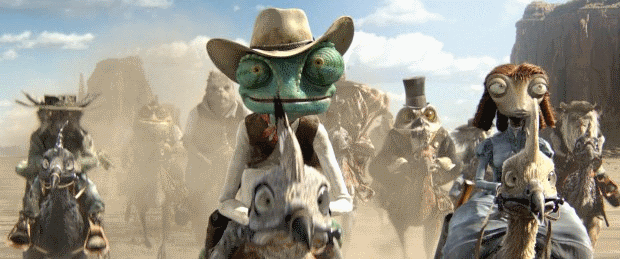Does Rango work because of, or in spite of his ocular resemblance to a real-life chameleon? Frankly, I don’t think it matters one way or the other: it’s Johnny Depp’s vocal and his ‘emotion-captured’ physical performances that brings Rango to life.
I thought Rango’s character design would sink Rango, but the little lizard works. Those teeny-tiny eyes set in bulging trackball sockets are completely counterintuitive – don’t director Gore Verbinski and company know you’re supposed to give animated characters oversized eyes? How else do you maximize a character’s expressiveness, not to mention evoke peoples’ instinctive response to feel affection for infants and children (and therefore for the character in question)?
Does Rango work because of, or in spite of his ocular resemblance to a real-life chameleon? Frankly, I don’t think it matters one way or the other: it’s Johnny Depp’s vocal and his ‘emotion-captured’ physical performances that brings Rango to life. I mentioned Verbinski’s cowboy dress-up strategy in my first write-up of the film: recording the actors not just reading their lines, but performing – andnot in tights and motion marking ping-pong balls either, but in Wild West drag. It’s a brilliant brainstorm that judging from the final results paid off nicely. (And I hope they include plenty of it – an entire scene perhaps? – on the blu-ray.)
Zemeckis aside (and I’m about to see his latest zombievision epic Mars Needs Moms) no one really likes motion-capture – even when the characters are given a non-realistic, stylized appearance, you can’t avoid a visit to that spooky ol’ Uncanny Valley. (Of course when I say ‘you,’ I mean me; your actual opinion may vary.) But providing animators with the actors’ entire physical performance gives the artists a bottom line to build on and add the larger-than-life flourishes that animation is all about.
That said, I’m giving Verbinski a pass on the realistically rendered human who starts off the film’s third act. (Even though other reviews will probably describe him in detail, I’m too classy to spoil the surprise.) He walks the Valley’s edge, but he’s rendered over-realistically, larger than life (or larger than Rango, at least), and his performance, I would wager, was animated from scratch and not mocapped.
Nor am I going to spill the beans on the not so realistically rendered human characters who do a surprise drive-by early in the film (although come to think of it, I did exactly that in my first write-up); that particular gag will totally fly over the kids’ heads while their parents are ROTFL.
Back to Depp’s performance: his lilting delivery of his overly elegant dialog holds its own against Captain Jack Sparrow or Willy Wonka’s offbeat vocalizations. (And there’s no shortage of multisyllabic words that will have the younger ones tugging on their parents’ sleeves to explain – “cogitation,” anyone?)
Did I mention Rango’s basic conceit? The lonely lizard, an amateur thespian who’s been performing his entire life for an audience of one (namely himself) finds himself in the all-animal, spaghetti western town of Dirt, and quickly takes on the role of sheriff. The film is replete with any number of amazingly choreographed, high-energy chase scenes that Rango survives through quick wits, luck and the strategic application of sheer cowardice.
There’s no shortage of throwaway visual gags, like the Pepto-Bismol bottle that serves as an outhouse, or the road runners the characters ride on as they posse their way across the desert. (And no, they don’t look anything like Warner Bros.’ superstar bird.) Last time around I talked about Industrial Light and Magic’s animation: animal characters who look enough like their natural counterparts to seem astonishingly real (and not in an uncanny way either), yet with enough expressiveness and human body language to never let you forget they’re imaginary beings. Attention must be paid as well to ILM’s physical renderings: the desert heat reflections, the rippling distortions seen through whiskey bottles and windows, the cascades of water, the atmospheric barroom lighting – all indistinguishable from the real thing.
I’m cool with Depp’s debt to Don Knotts’ delusional bravado in films like The Shakiest Gun in the West or the chase scene with a Road Warrior payoff, but I have reservations about Rango’s deliberate debt to Chinatown, with control of the town’s water supply driving the narrative, and an elderly mayor (voiced by Ned Beatty doing an excellent John Huston impression) who keeps enthusing about The Future. (No Charge Spoiler: he’s the villain.)
Did I just parenthetically call Dirt’s mayor the villain? The real baddie is a satanically serpentine reptile known as Rattlesnake Jake, voiced by Bill Nighy. (No Charge Spoiler No. 2: he’s a rattlesnake.) When Rango threatens to send him to Hell, Jake responds “where do you think I come from?” Evil beyond evil, Jake is as capable of playing mind games with his victims as crushing them in his coils. Bullet-stocked bandoleer after bandoleer decorate his length, he sports a Gatling gun in place of a rattle and his slithering is accompanied by the creepiest hissing and ratcheting sound effect one can imagine. Jake now occupies the top of my short list for Best Animated Feature Villain of All Time.








